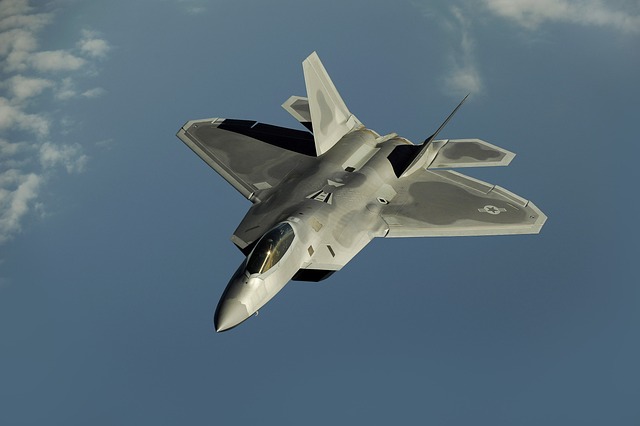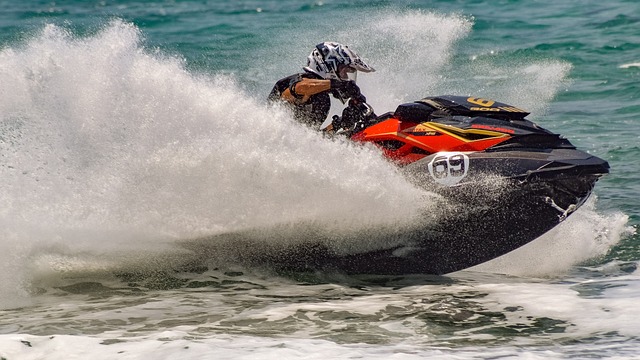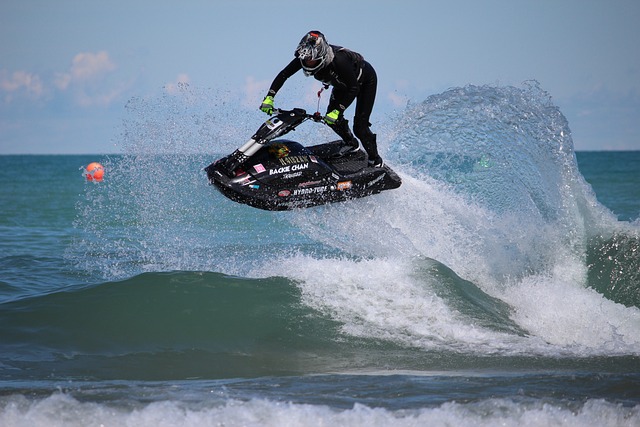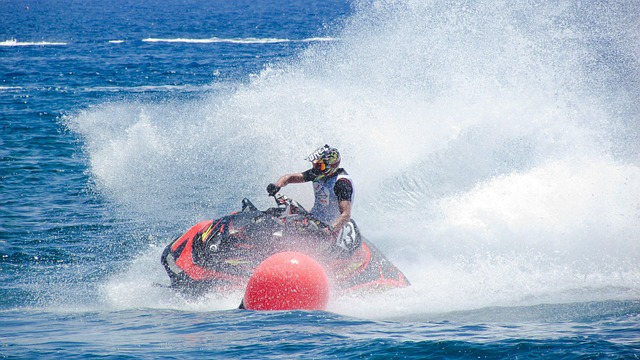Jet Ski JBR (Offshore Racing) is a high-speed, thrilling sport where modified jet skis compete on open water. With speeds exceeding 70 mph, it combines cutting-edge technology, advanced aerodynamics, and powerful engines. The JBR class includes stock and modified divisions, appealing to both standard power enthusiasts and customizers. Races operate under strict safety rules and regulations, with organizers ensuring fair play and environmental stewardship. To participate, athletes need proper training, quality gear, and adherence to rules, offering an exhilarating experience while prioritizing safety in challenging marine conditions.
“Discover the thrilling world of offshore racing with a focus on the powerful Jet Ski JBR class. This article explores the origins and evolution of this high-performance watercraft, from its humble beginnings to becoming a global phenomenon. We’ll dive into the different types of JBR jet skis, navigate the rules and regulations governing these races, and uncover the unique excitement and challenges that attract competitors worldwide. Get ready to rev up your engine as we share top tips for those eager to participate in this dynamic sport.”
- What is Offshore Racing JBR?
- History and Evolution of Jet Ski JBR
- Types of Jet Skis in the JBR Class
- Rules and Regulations for JBR Races
- The Excitement and Challenges of Offshore Racing
- Top Tips for Participating in JBR Events
What is Offshore Racing JBR?

Offshore Racing JBR refers to competitive events featuring high-performance jet skis, specifically designed for racing on open water bodies such as oceans and large lakes. This thrilling sport pushes the limits of speed, agility, and skill, with participants navigating through challenging courses marked by buoys or other navigation aids. Jet Ski JBR requires not just powerful machines but also exceptional handling, strategic planning, and an understanding of marine conditions.
The JBR (Jet Ski Racing) category focuses on modifying standard jet skis to enhance performance while adhering to strict safety guidelines set by racing organizations. These modifications include upgrades to engines, exhaust systems, and hydrofoils, enabling the jet skis to achieve remarkable speeds, often surpassing 70 mph (113 km/h). The sport attracts both professional athletes and entusiast amateurs, who compete in various championships around the globe, showcasing their expertise and passion for watercraft racing.
History and Evolution of Jet Ski JBR

The Jet Ski JBR, a powerhouse in offshore racing, has an intriguing history that traces back to the early days of personal watercraft. This evolution began with the introduction of jet-powered vehicles, which captured the hearts and imaginations of thrill-seekers worldwide. Over time, these machines transformed from simple prototypes into highly specialized racing platforms. The JBR (Jet Ski Big Race) emerged as a dominant force, pushing the boundaries of speed and performance in competitive events.
Design innovations played a pivotal role in the JBR’s history. Engineers focused on enhancing stability, maneuverability, and engine efficiency to create machines capable of achieving extraordinary velocities. Today, the JBR is synonymous with cutting-edge technology, advanced aerodynamics, and powerful engines, making it a favorite among racing enthusiasts and professionals alike. This continuous evolution has not only pushed the limits of what jet skis can do but has also captivated audiences worldwide with its breathtaking performances during high-stakes offshore races.
Types of Jet Skis in the JBR Class

The JBR (Jet Ski Racing) class is a thrilling category that showcases some of the most advanced and powerful jet skis on the water. In this high-performance racing arena, several types of jet skis compete, each with unique features tailored for speed and agility. The two primary categories include stock and modified classes, allowing for exciting competition among both factory-produced models and customized machines.
Stock JBR jet skis represent the out-of-the-box performance vehicles, where racers rely on the manufacturer’s specifications. On the other hand, the modified class is where creativity and innovation shine, as riders enhance their jet skis with specialized components, fine-tuning them for optimal racing conditions. These diverse types ensure that the JBR racing series appeals to a wide range of enthusiasts, from those who appreciate off-the-shelf power to the customizers seeking to push boundaries.
Rules and Regulations for JBR Races

Jet Ski JBR races are governed by a set of strict rules and regulations designed to ensure safety, fairness, and sustainability in this high-speed sport. Participants must adhere to local and international laws regarding watercraft operations, including speed limits, protective gear requirements, and environmental protection measures. Each race has specific guidelines on start times, course layouts, and permitted equipment modifications, which are clearly communicated before the event to all competitors.
Organizers often collaborate with relevant authorities to enforce these rules, conducting thorough inspections of jet skis and ensuring riders meet safety standards. Penalties for violations can range from time penalties during the race to disqualification or even legal repercussions for more serious offenses. These regulations not only protect participants but also promote a responsible approach to offshore racing, preserving the integrity and excitement of Jet Ski JBR events.
The Excitement and Challenges of Offshore Racing

Offshore racing, particularly on high-performance jet skis like the JBR, is a thrilling and challenging sport that captivates enthusiasts worldwide. The sense of speed and freedom as these powerful machines slice through the waves is unparalleled. Participants embrace the rush of adrenaline as they navigate treacherous courses, testing their skills and pushing the boundaries of what’s possible in an exhilarating race against time and competitors.
However, this extreme sport also presents numerous challenges. Navigating turbulent seas, unpredictable weather conditions, and navigating around obstacles demand precision and expertise. Jet ski racers must possess not only exceptional handling skills but also a deep understanding of their machine’s capabilities and limitations. The JBR, known for its cutting-edge technology and agile design, requires a skilled operator to unlock its full potential while ensuring safety in the face of these demanding conditions.
Top Tips for Participating in JBR Events

Participating in Jet Ski JBR (Offshore Racing) events can be an exhilarating experience, but it requires preparation and knowledge to ensure a safe and enjoyable time. Here are some top tips for aspiring jet ski racers:
First, familiarize yourself with the rules and regulations of JBR competitions. Understanding the safety protocols, course markings, and racing procedures is crucial. Second, invest in high-quality gear including protective clothing, life jackets, and a well-maintained jet ski suitable for offshore racing. Proper training is also key; consider enrolling in a few practice sessions or clinics to hone your skills in handling waves, turns, and different water conditions. Lastly, stay focused during the race, maintain a steady pace, and adapt to changing weather and sea conditions to give yourself the best chance at victory while ensuring a safe journey.
Offshore racing JBR, an exhilarating category within the world of jet skiing, combines cutting-edge technology with adrenaline-pumping speed. From its humble beginnings to its current global popularity, the Jet Ski JBR has evolved into a true test of skill and endurance. With various types of craft available and strict regulations ensuring fair competition, this dynamic sport offers both thrill-seekers and seasoned athletes an unforgettable experience. By understanding the rules, embracing the challenges, and heeding top tips for participation, aspiring jet skiers can fully immerse themselves in the electrifying world of JBR racing.
